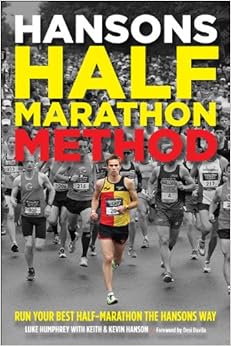This is the fourth in a series of summaries of the different aspects of
the Hansons' Half Marathon Method I'm using for my fall training. The first was on easy runs, the second was on tempo runs, and the third was on speed workouts.
The Hanson's method approaches long runs differently than most training plans. The book says
"...Much of the existing advice on running long is misguided. After relatively low-mileage weeks, some plans suggest grueling long runs that end up more akin to running misadventures than productive training. For example, a 16-mile long run at the end of a 3-day-a-week half-marathon training program can be both demoralizing and injurious.
Our approach to the half-marathon is thoughtful and methodical, with long run mileage chosen in line with the overall goal of achieving cumulative fatigue [which is] key to the Hansons Method's success. However, the long run should successfully stimulate this effect without completely zapping your legs. This way, rather than spending the entire week recovering from the previous long run, you continue to build your base for the forthcoming long effort."
There is no rest day before the long run, and while the plan overall "allows for partial recovery, it is designed to keep you from feeling completely fresh going into your long run."
Essentially, running the long runs without feeling fresh mimics the tired feeling you get at the end of a race, which is essential training for race day.
The benefits of long runs are, "Improved V02 max, increased capillary growth, a stronger heart, and the ability to utilize fat on a cellular level....When your body is trained to run long, it adapts and learns to store more glycogen, thereby allowing you to go farther before becoming exhausted."
The guidelines for long runs come from renowned running research and coach Dr. Jack Daniels, who advises never to exceed 25-30% of weekly mileage in a long run, whether training for a 5K, half marathon, or marathon. So, if you're running 20 miles a week, 30% of that volume is a 6-mile long run. For a 30-mile week, 30% of volume is a 9-mile long run, and for a 40-mile week, 30% of volume is a 12-mile run. He also enforces a 2:30-3:00 hour time limit on long runs, "suggesting that exceeding those guidelines offers no physiological benefit and may lead to overttraining, injuries, and burnout."
"Instead of flirting with the point of diminishing returns and prescribing an arbitrary 20-mile run, the Hansons Method looks at percentage of weekly mileage and time spent running. We determine your long run based on your weekly total mileage and your pace for that long run. It may sound unconventional, but you'll find that nothing we suggest is random; it is firmly based in science, with proven results."
That paragraph is specifically talking about the 16-mile max long long run in the full marathon plan, which gets a lot of controversy. But the same approach is taken with choosing long run distances for the half marathon plan.
Pace is also part of the equation. "If you are new to running or new to running long distances, the first goal is to simply build your endurance. In that case, running slow enough to be able to cover the distance is the objective." Otherwise, the plan suggests a moderate pace, about 1:15/mile slower than race pace.
My long runs for the rest of the plan vary between 10 and 12 miles and are proportionate to the weekly volume so that the long run makes up 25-3% of weekly volume throughout the program. I did my first long, 10-mile run at moderate pace last weekend, and I have to say that I was zapped! I think it was the hardest run I've done on the plan so far. However, it was extremely hot, and I didn't get an early a start as I wanted plus I didn't bring as many salt stick caps as I should have, so that likely played a role. This weekend I want to be smarter and go earlier to beat the heat, so I'm curious how this long run goes.
The long run is probably the most infamous and controversial part of the Hansons' marathon method that many runners have heard about, because most runners don't believe a 16-mile max long run will prepare them for a long run. But here you can see the reasoning for that and how it's applied to the half marathon method. Labels: Hansons Half Marathon Method
